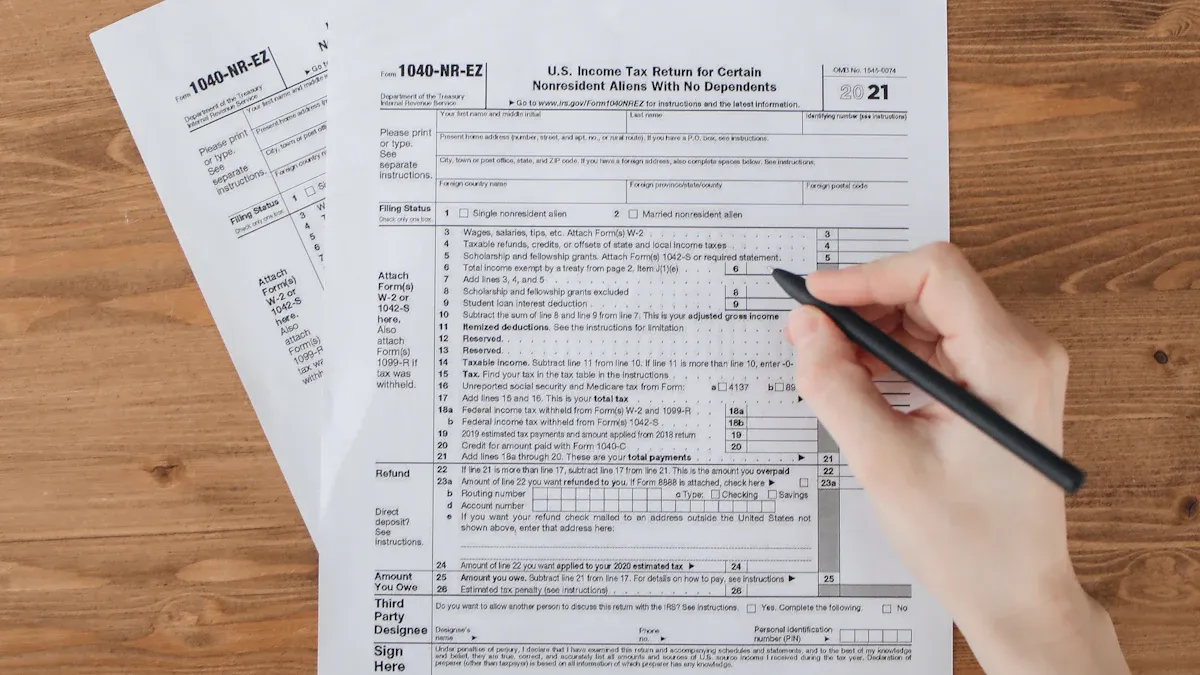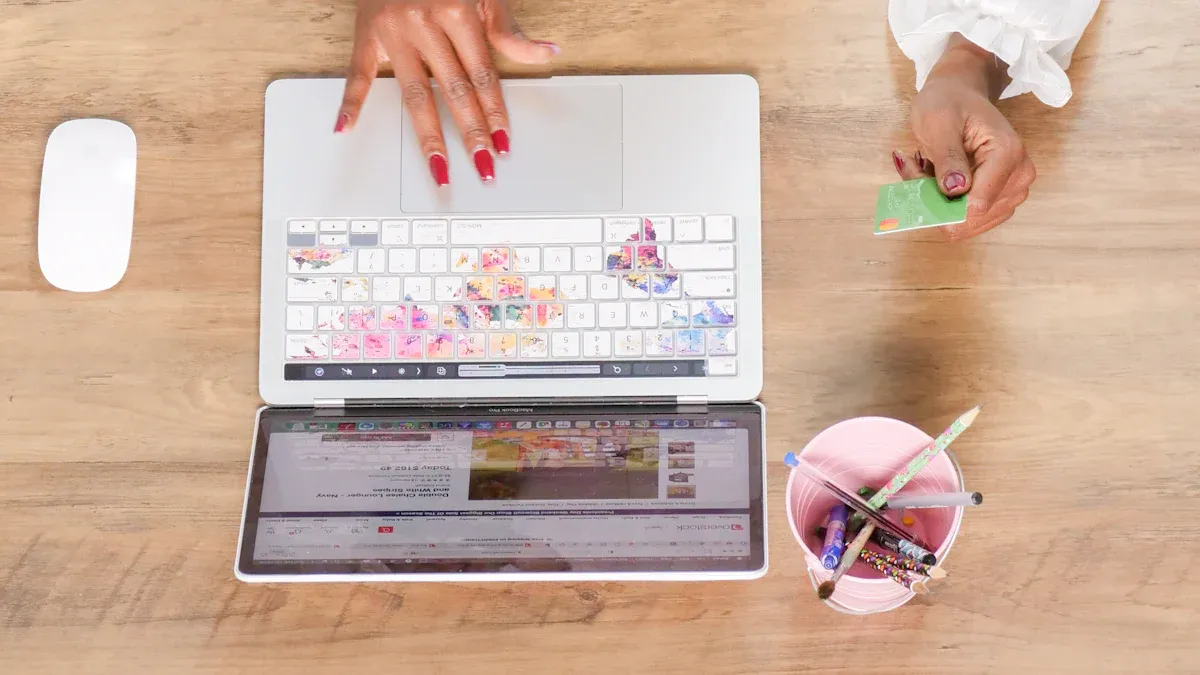- EasyCard
- Trade
- Help
- Announcement
- Academy
- SWIFT Code
- Iban Number
- Referral
- Customer Service
- Blog
- Creator
Tips for avoiding mistakes when filling out a CVS money order

Image Source: pexels
You can feel confident when getting a cvs money order if you take a few simple steps. Many people worry about writing the recipient’s name or address wrong, signing in the wrong place, or losing their receipt. These concerns matter because incorrect information can cause payment problems. When you fill out a cvs money order, write the recipient’s name exactly as needed, sign the front, and keep your receipt. This way, you protect yourself and make sure your money order goes to the right person.
Key Takeaways
- Write the recipient’s full legal or business name clearly to avoid payment problems.
- Fill in your own name and address correctly and sign on the front to validate the money order.
- Complete the money order right after purchase and double-check all details before leaving.
- Keep your receipt safe to track the payment or request a refund if needed.
- If you make a mistake, ask CVS staff for help instead of fixing it yourself.
CVS Money Order Mistakes

Image Source: pexels
Common Errors
When you fill out a cvs money order, you might make some common mistakes. These errors can cause delays or even make your payment invalid. Here are some mistakes you should watch out for:
- Writing the payer’s name in the payee field.
- Misspelling the recipient’s name or using a nickname instead of the legal or business name.
- Leaving your own name or address blank, or writing them incorrectly.
- Not signing the money order in the correct place on the front.
- Leaving the “Pay to the Order” section empty.
- Throwing away or losing the receipt before the recipient confirms payment.
- Not reading the terms and conditions before purchasing money orders.
- Writing bank information in the address section instead of your own address.
Note: If you make any of these mistakes, you may have trouble getting a refund or tracking your payment. Always check the money order fees and keep your receipt safe.
How to Avoid Them
You can avoid most mistakes by following a few simple steps. Here is a checklist to help you fill out your cvs money order correctly:
- Write the recipient’s legal or business name clearly in ink. This prevents confusion and tampering.
- Fill in your name and address in the correct sections. Do not include bank information.
- Sign the front of the money order where it says “Purchaser/Signer for Drawer.” Do not sign the back.
- Double-check all information before you finish. Make sure everything is correct and easy to read.
- Fill out the money order right after you buy it. This helps prevent theft or fraud.
- Keep the receipt until the recipient confirms they received the money order. The receipt has a tracking number for help with lost or stolen payments.
- If you make a mistake, do not try to fix it yourself. Ask a CVS staff member for help because policies can vary.
By following these steps, you can avoid most problems and make sure your cvs money order gets to the right person.
Fill Out a Money Order Correctly

Image Source: pexels
Filling out a money order form at CVS is easy when you follow a step-by-step guide. You can avoid mistakes and make sure your payment goes to the right person. Here is how you can fill out a money order correctly:
Recipient’s Name
The first step is to fill in the name of the recipient. Write the recipient’s full legal name or business name in the “Pay to the Order of” field. This makes sure only the person or business you choose can cash the money order. Always use a pen and write clearly. If you misspell the recipient’s name, the bank or business may not accept the money order. This can cause delays or even prevent the payment from going through. Before you hand over the money order, double-check the spelling. If you find a mistake, do not try to fix it yourself. Ask the CVS staff for help. Different companies have different rules for fixing errors, so it is best to get help right away.
Tip: Carefully review the money order before sending it. A small mistake in the recipient’s name can cause big problems.
Purchaser’s Information
Next, you need to add your address and name in the “Purchaser” or “From” section. This helps track the payment and makes it easier to get a refund if needed. Use your own address, not the recipient’s. Write your information clearly and check for errors. Your signature is also required on the front of the money order, usually near the bottom. This signature is important because it validates the money order, just like signing a check. Without your signature, the money order is not valid.
Memo or Account Number
The memo or account number field is optional, but it can be very helpful. You can use this space to write an account number, bill number, or a short note about the payment. For example, if you are paying a bill, write the account number here. This helps the recipient know exactly what the payment is for and makes sure they apply it to the right account. If you do not need to include any extra information, you can leave this field blank.
Table: What to Write in the Memo Field
| Situation | What to Write |
|---|---|
| Paying a bill | Account number |
| Sending a gift | Occasion or note |
| Business payment | Invoice or reference |
| No extra info needed | Leave blank |
Signature
The last step is to sign the money order in the correct place. Look for the line that says “Purchaser’s Signature” or “Signer for Drawer.” Sign your name using a pen. Do not sign the back of the money order. Only the front needs your signature. This step is important because it makes the money order valid. If you forget to sign, the recipient may not be able to cash it.
Note: Always complete the money order right after you buy it. This prevents anyone else from filling in the details and cashing it without your permission.
After you fill out a money order, keep the receipt. The receipt has a tracking number. If the money order gets lost or stolen, you can use this number to track it or request a refund.
By following this step-by-step guide, you can fill out a money order form with confidence. Remember to fill in the name of the recipient, add your address, include a memo if needed, and sign in the right place. Always use a pen, double-check your work, and keep your receipt safe.
Money Order Error Solutions
If You Make a Mistake
Mistakes can happen when you fill out a money order. You might write the wrong name, enter the wrong amount, or sign in the wrong place. If you notice an error before you leave CVS, do not try to fix it by crossing out or using correction fluid. This can make the money order invalid. Instead, follow these steps:
- Stop writing as soon as you notice the mistake.
- Show the error to a CVS staff member right away.
- Ask if you can get a replacement or a refund. CVS staff will explain the next steps.
- Keep your receipt. You will need it to prove your purchase and track your payment.
Tip: Never throw away a money order with a mistake. You may need it to request a refund or replacement.
If you already left the store, contact the customer service number on your receipt. They will guide you on what to do next. Some companies may charge a fee for canceling or replacing a money order. Fees can range from $5 to $15 USD. Always check the latest rates before making a request.
Getting Help
You can get help if you have questions or problems with your money order. CVS staff can answer basic questions about filling out the form. For more complex issues, use the contact information on your receipt. Most money order providers have a customer service hotline and a website with FAQs.
Here is a quick table to help you know where to get help:
| Problem Type | Who to Contact |
|---|---|
| Filling out the form | CVS staff |
| Lost or stolen money order | Provider’s customer service |
| Refund or replacement | Provider’s customer service |
| Tracking payment | Provider’s website or hotline |
Note: Always keep your receipt until the money order is cashed or deposited. The receipt is your proof of purchase and helps you track or replace your payment if needed.
Best Practices
Review Before Leaving
You should always check your money order before you leave the CVS counter. Take a moment to look over every detail. Make sure you wrote the recipient’s name correctly. Confirm that your own name and address are in the right spots. Check that you signed in the correct place on the front. If you added a memo or account number, make sure it is clear and accurate.
A quick review can help you spot mistakes early. If you find an error, ask a CVS staff member for help right away. Staff can guide you on what to do next. This step saves you time and prevents problems later. Many people forget to double-check, but this habit can protect your payment.
Tip: Hold your money order up to the light to make sure all writing is easy to read and nothing is smudged.
Keep Your Receipt
After you finish filling out your money order, keep the receipt in a safe place. The receipt is more than just a slip of paper. It gives you important protection if something goes wrong.
- The receipt acts as proof of payment for the money order.
- It contains a tracking number that lets you check if the payment reached the right person.
- If the money order gets lost or stolen, you need the receipt to request a stop payment or a replacement. Some providers may charge a fee for this service.
You can store your receipt in your wallet or take a photo of it with your phone. Never throw it away until you know the money order has been cashed or deposited. If you lose the receipt, it becomes much harder to track or replace your payment.
Note: Always keep your receipt until you confirm the money order has reached the recipient.
You can avoid most problems with a cvs money order by taking your time and following each step carefully. Here is a quick checklist to help you remember what to do:
- Write the recipient’s name in the correct field.
- Add your own details in the purchaser section.
- Include any account number or memo if needed.
- Sign the money order to make it valid.
- Keep your receipt for tracking or help.
Careful attention to these steps helps you prevent common errors. If you have questions or make a mistake, you can always ask for help at CVS or contact the provider’s customer service.
FAQ
How much does a CVS money order cost?
You pay a fee of about $1.25 USD for each money order at CVS. The maximum amount for one money order is $500 USD. Always check the current exchange rate if you need to compare with other currencies.
Can you track a CVS money order?
Yes. Use the tracking number on your receipt. Visit the provider’s website or call their hotline. You can check if the money order has been cashed or deposited.
What should you do if you lose your money order receipt?
If you lose your receipt, contact the money order provider’s customer service. You may need to fill out a form and pay a fee. Without the receipt, tracking or replacing your money order becomes much harder.
Can you deposit a CVS money order into a Hong Kong bank account?
Yes. Many Hong Kong banks accept money orders. You must endorse the money order and provide identification. Check with your bank for their rules and possible fees.
| Bank Name | Accepts Money Orders | Extra Fee (USD) |
|---|---|---|
| HSBC Hong Kong | Yes | $10 |
| Bank of China HK | Yes | $8 |
| Hang Seng Bank | Yes | $12 |
This guide shows you how to navigate the manual process of a CVS money order, protecting you from common mistakes. While a money order is a reliable tool for some domestic payments, its paper-based nature makes it inconvenient, slow, and expensive, especially for cross-border transactions. As the FAQ highlights, depositing a money order into a Hong Kong bank account comes with extra fees and a manual process. The need to keep a paper receipt, the risk of human error, and the lack of real-time tracking are all limitations that a modern financial solution can solve. This is where BiyaPay offers a modern, transparent, and direct solution that digitizes and simplifies global payments. Our platform provides real-time exchange rate queries and conversions, with remittance fees as low as 0.5%, significantly lower than the combined costs of a money order and bank deposit fees.
Instead of filling out a paper form and worrying about mistakes, you can complete a secure digital transfer in minutes. BiyaPay eliminates the need for physical receipts and provides end-to-end tracking, giving you peace of mind. Our same-day delivery for many transfers ensures your recipient receives the money quickly, without the need for a trip to the bank or a complex deposit process. Don’t let the risk of error and high fees hold you back. Open a secure account with BiyaPay in minutes and experience a new standard for global finance. Register now to streamline your international transactions.
*This article is provided for general information purposes and does not constitute legal, tax or other professional advice from BiyaPay or its subsidiaries and its affiliates, and it is not intended as a substitute for obtaining advice from a financial advisor or any other professional.
We make no representations, warranties or warranties, express or implied, as to the accuracy, completeness or timeliness of the contents of this publication.




Contact Us
Company and Team
BiyaPay Products
Customer Services
is a broker-dealer registered with the U.S. Securities and Exchange Commission (SEC) (No.: 802-127417), member of the Financial Industry Regulatory Authority (FINRA) (CRD: 325027), member of the Securities Investor Protection Corporation (SIPC), and regulated by FINRA and SEC.
registered with the US Financial Crimes Enforcement Network (FinCEN), as a Money Services Business (MSB), registration number: 31000218637349, and regulated by FinCEN.
registered as Financial Service Provider (FSP number: FSP1007221) in New Zealand, and is a member of the Financial Dispute Resolution Scheme, a New Zealand independent dispute resolution service provider.



















